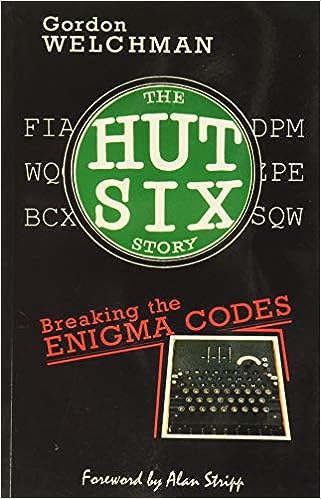The Hut Six Story
ISBN 978-0947712341

One wonders what Gordon Welchman might have done or been if there had not been a war, and had he not been invited to Bletchley Park to break German codes. He might still have taught the first computer programming course. Maybe not. The type of thinking that was used in World War II, though, lead almost directly to modern day computers since one required computational power in order to break enciphered messages. Usually, those picked for this task had backgrounds in mathematics although certainly there were also those who had backgrounds in linguistics. Mr. Welchman was a mathematician by training and so received the invite. In his book The Hut Six Story he recounts his time and recollections during his time there at Bletchley. Despite this book being published in 1982, the intelligence agencies of Britain were, apparently, still miffed that he told the tale. Mr. Welchman was certainly not the first to do so but he was seemingly the only one to have his security clearances taken as retaliation. The tone of this book is not that of an author who believes he is disclosing secrets that are not a matter of public record. Rather, he is trying to correct some inconsistencies in the public record as well as add his own perspective.
To be sure, it is not an easy read. Some of this is because the terminology in the book is specific to the Enigma but more than a little of it concerns the language not being standard in the early years of code breaking and electrical engineering. The idea is fresh in the mind of Welchman since he lived it. It is a harder, though, to gain a full picture in this telling, although it is less the author’s fault and more the complicated logic that the Enigma machines were designed to embody that causes the confusion.
We learn that Welchman intuits some ways to break through the Enigma encryption scheme. Most of these methods rely on German mistakes in using the technology. Welchman then begins to organize the apparatuses and methodology and staffing that will allow him to formulate and implement a code-breaking regiment.
Toward the end of the book, we learn that Welchman is more “re-engineering” what some Polish cryptographers had surmised and most likely at the very least Welchman’s senior, Dilly Knox, likely knew something more than Knox let on about these efforts since Knox was himself a component and a quasi-legend as an “Enigma” breaker. Everyone it seems is fighting for credit and recognition concerning who broke Enigma and when. One gets the feeling, however, that Welchman really is not after any of that. He seems, initially at least, just to enjoy the thought of being able to break the codes.
There are a million interesting points in the book concerning figures like Turing and interactions and conversations that were occurring in the breaking of these ciphers. Most interestingly, Welchman reflects back on his time at Bletchley as some of the happiest time in his life and mentions that the same was true for many others who worked there. Perhaps it was the unified feeling of facing a common foe and having a sense of purpose that drove everyone to do more than they might normally was the cause of this feeling. Clearly, later on, it is not the case when Welchman publishes this work. The valued asset has become the liability. This permutation is a shame because it is evidently clear that the man loved doing the work he did.
Welchman eventually becomes a mechanical engineer predominately and oversees the construction of the “bombes” which are machines that aid in helping to break enigma codes. These machines work by brute force and by anticipating “cribs” or stylistic elements of messages that are likely to be present and therefore act as a kind of sanity check for any potential deciphers. Welchman also realizes some shortcuts that can be introduced to the calculation of the “bombes” by way of realizing the fact that some letters are encoded in a two-way relation to one another. Put bluntly if A, then B, and if B, then A. The realization involves a time factor from days to hours before potential breaks could occur.
Eventually Welchman comes to the United States and becomes a US citizen. He works for a corporation called The Mitre Corporation which specializes in secure communications for the US military. Not much of this work is discussed, but Welchman does discuss some prescient matters that he considers key if we are to keep our communication secure moving forward. Many of these issues are still present today, and involve mistakes human beings make when they are dealing with complex codes. One gets lazy, for instance, and might not scramble the settings sufficiently or else they might transmit the same message with two separate settings which allow for greater understanding and breakthroughs for those who wish to decipher such messages. Many of these insights in the computer age are self-apparent, but they were not at the start of WWII and certainly were not as evident in 1982. The weakest link in any encryption scheme will always be human beings.
Welchman dies not long after this book is published in 1985. There is a strong indication that this death might have come from being broken-hearted about his treatment after publishing this account.
Though this reading is very dry at times, it is a must for any serious student of WWII and encryption or even modern computer programming. Once one begins to adapt the language to a more modern idiom, the kinds of problems Welchman tackles are still the ones being tackled today.
